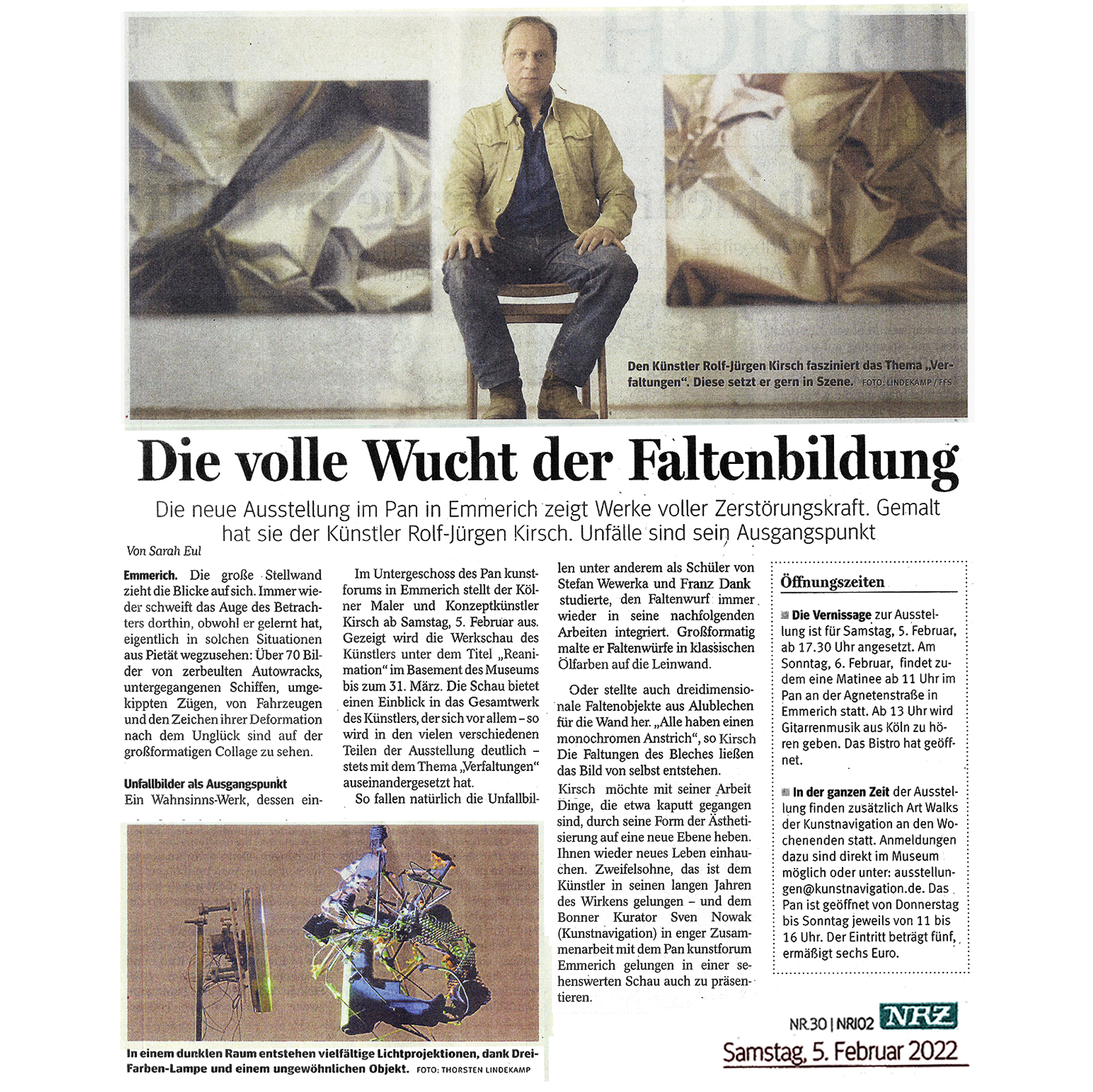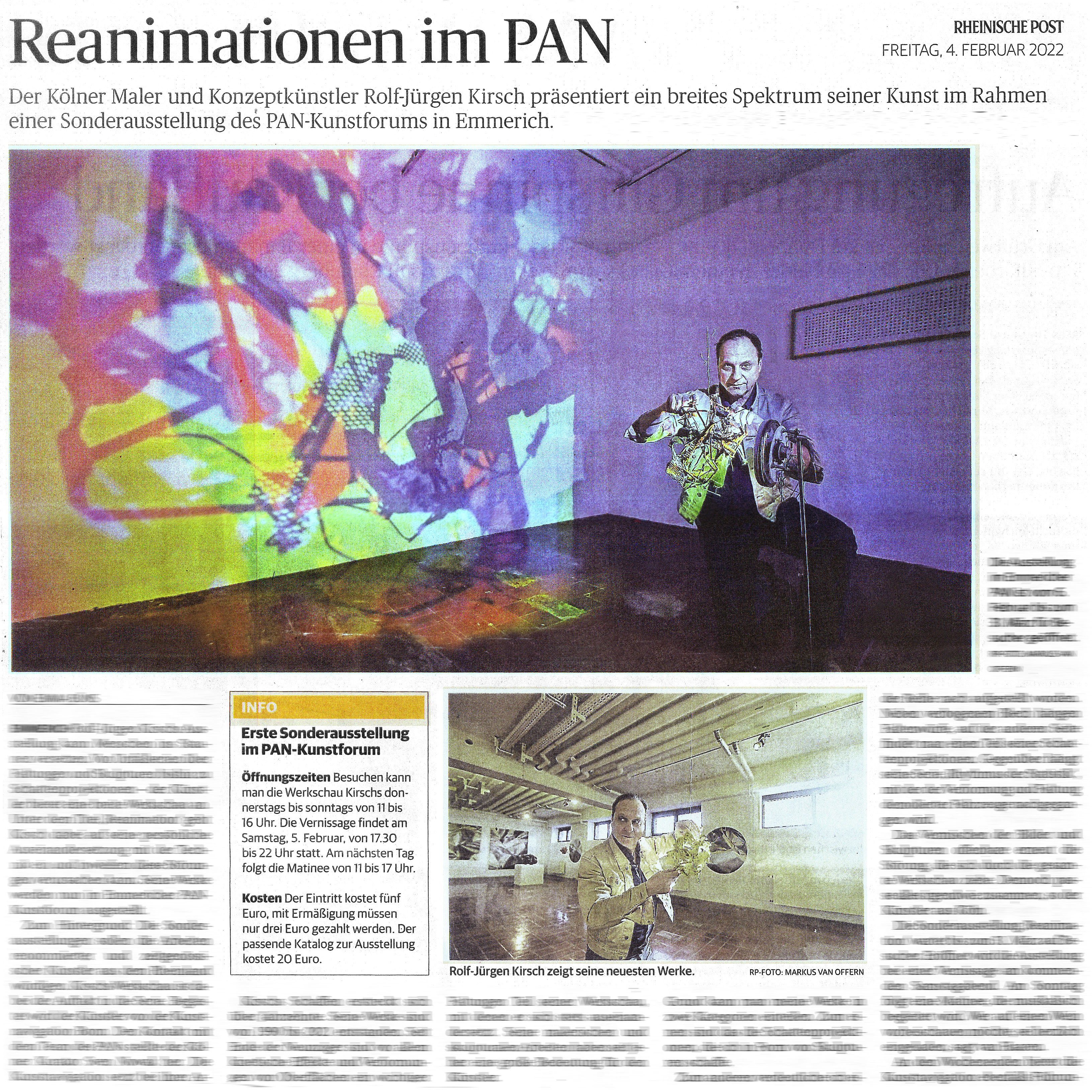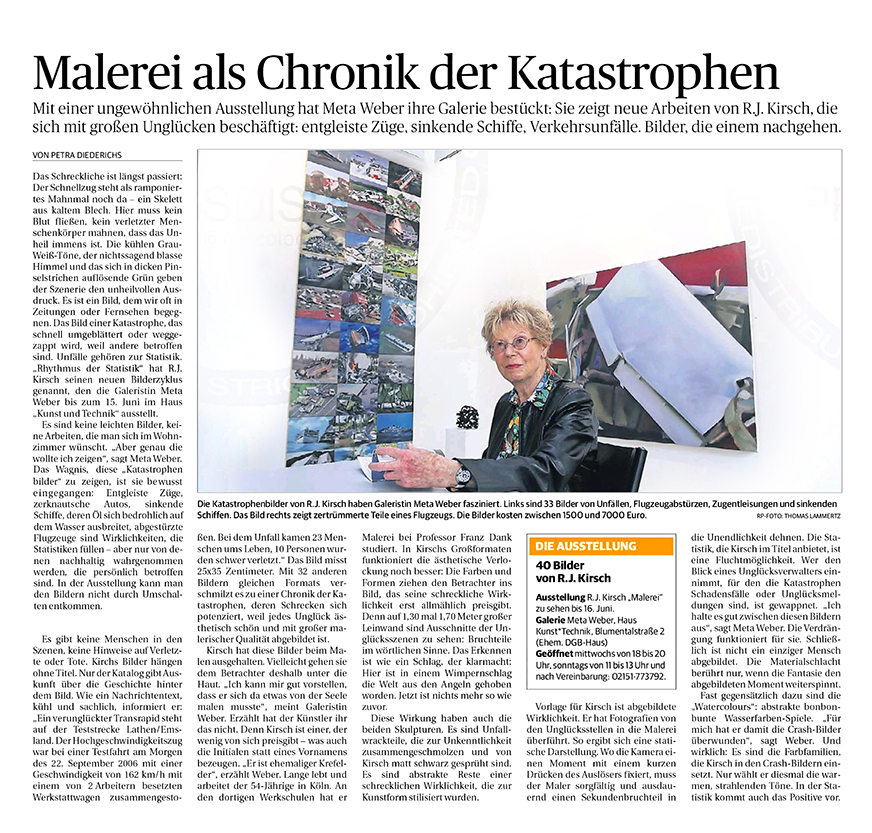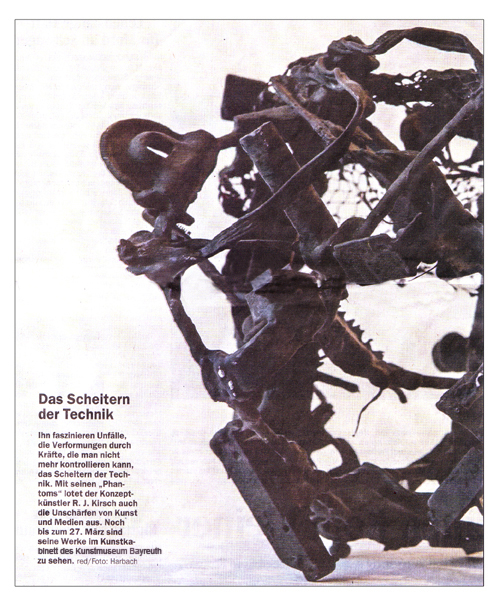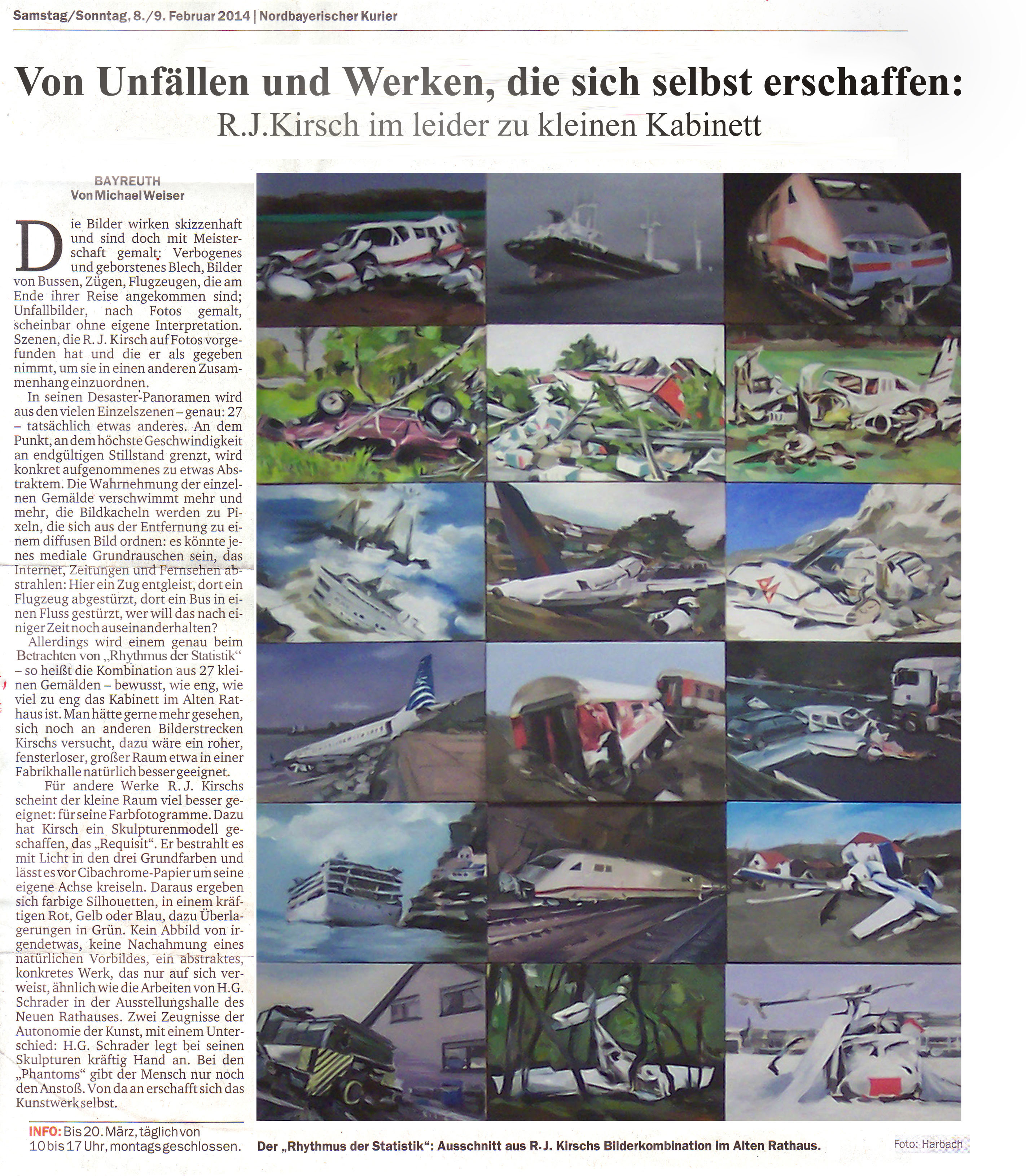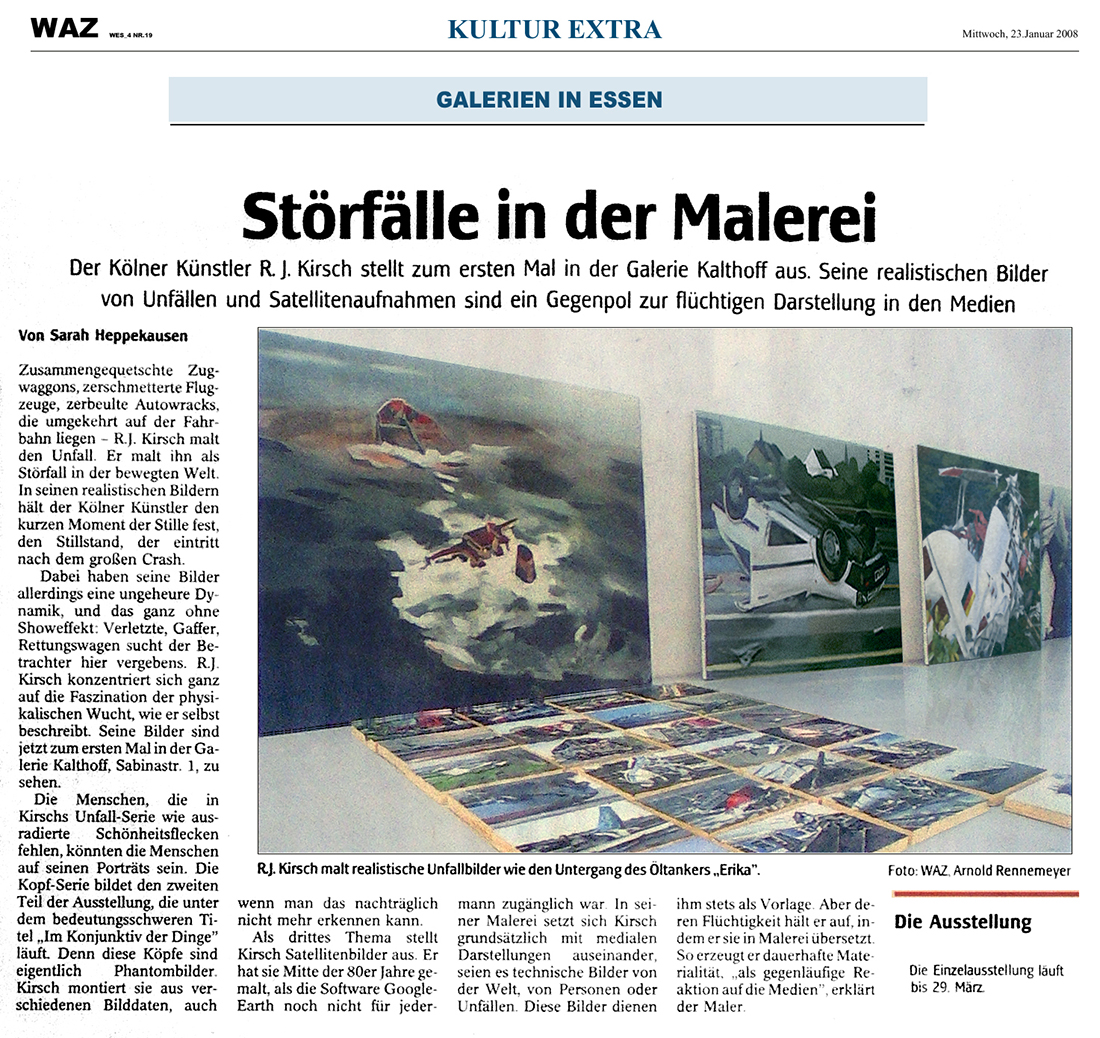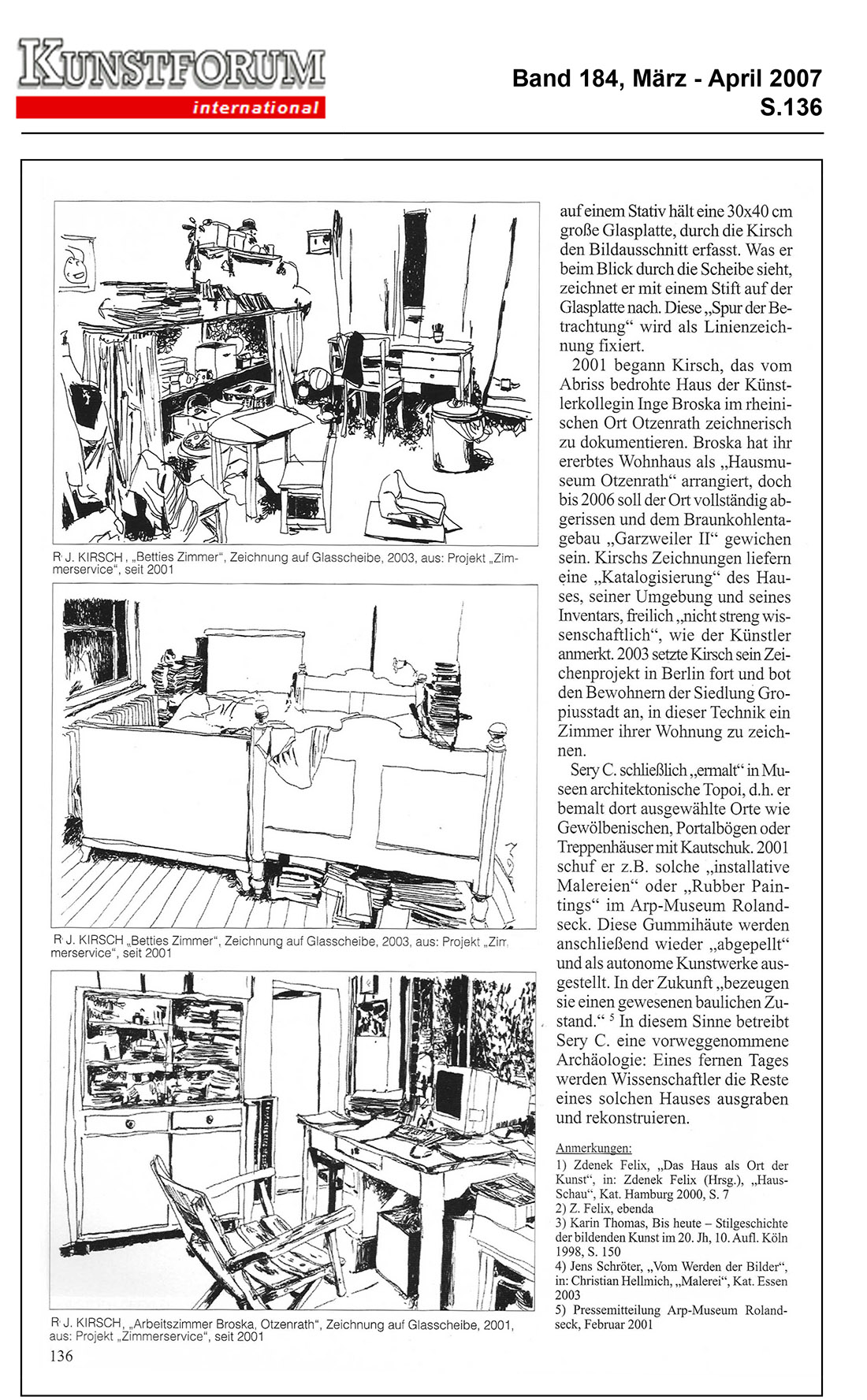Kirsch rejects the concepts of acceleration and abstraction. Stylistically consistent, the painter brakes down in as virtuoso a way as realistic in every sense. paintings show the principle of unrestricted mobility.
Dr. Ulrike Brandenburg, Wiesbadener Kurier
more...
Kirsch obviously does not belong to that type of artist that is still widespread, who specializes in a form of expression to express it, already alone of the Recognizability effect due to the ability to constantly vary and repeat. On the contrary - the heterogeneous spectrum of his artistic means and process corresponds to the theme that moves his art from the very beginning and that inspired: the ever-changing relationship to be defined between the medial and and the fine arts, namely painting. That sounds like this not particularly new, but is one of the great subjects of the postmodern art par excellence. Since the end of the 80s, however, Kirsch has had its very own and innovative create pictorial language for these "second-hand pictures", as he himself Work characterized. They are based on medial models from rather artless Contexts which he artistically appropriates, one could also say transformed. His gaze always remains there, despite his fascination with the world of media imagery, also distanced-critical, and an ironic note is usually involved.[...] In view of the speed with which the digital industry is constantly developing new imaging methods on the market, it will become an important task of art, of the unleashed technology to oppose phases of reflection and pause. With his art, Rolf Kirsch shows us how exciting and diverse this can be.
Dr. Sabine Schütz, Cologne, Opening Speech Kunstverein Viernheim 2013
The relationship between painting and media is his general theme, which is played through on objects of the high technology of the progress of speed. The walk through the second exhibition venue of the Viernheimer Kunstverein, the Kunsthaus, resembles a ramble through the philosophy of Paul Virilio and his critique of the frenzy of modernism. On around 100 small-format oil sketches by Rolf Kirsch, she has come to a standstill, the sunk cruise ship, crashed airplanes, crashed ICEs, buses sinking into the floods, trucks shattered into abysses, slashed and derailed wagons, all pictures of real accidents, of catastrophes that actually took place, but which Rolf Kirsch painted according to documentary photographs from the media.
exhibition review / SWR 2 - Theo Schneider
The artist calls these pictures on the damaged airplanes "the rhythm of statistics", ships or vehicles are visible. The templates for this come from the media, but have been is by no means voyeuristically implemented. People are searched in vain in these pictures. Kirsch rather painterly analyses the aggregate states of deforming materials. Here the accidental accident to the calculated idea.
Feuilleton, Kölner Stadtanzeiger - Emmanuel von Stein
They are handcrafted, perfectly painted pictures, the subject of which you don't really want to take a closer look at. If you try to ignore the tragedy of the whole, you can at least admire the physical forces that are skilfully translated into painting here.
Michaela Plattenteich, WZ, Krefeld
Rolf Kirsch will present various exemplary photographs from their already decontextualized environment, for example from the Image search of a web browser, transferred to the traditional medium of the canvas. The traffic, airplane and ship accidents represented in one block can be in general categories such as "catastrophes". However, the recipient is left in the dark about more precise connections - an enlightening readability remains excluded for the time being. However, the artist uses the realistic representation in his painting, in order to identify the transformation process, which was not apparent at first, on closer inspection. It becomes apparent that he traces the reproduced image worlds back to a haptic basis. In this context, Rolf Kirsch guides the photographs he has collected through which new contents of meaning, which for the viewer are now again a part of the work of art. become concretely legible. Through this almost didactic trick, he allows him to become a media-critical observer.
Stephan Frank, OSTRALE Catalogue, Dresden
In Kirsch's large formats, the aesthetic enticement works even better: The colors and shapes draw the viewer into the picture, which is his or her horrible reality is only gradually revealed. Because on 1.30 times 1.70 meters large The canvas shows excerpts of the unlucky scenes: Fractions in the literal sense. Recognition is like a blow that makes it clear: Here, in the blink of an eye the world has been unhinged. Now nothing is the same as before. The two sculptures also have this effect. They are accident wreckage, melted together beyond recognition and sprayed matt black by Kirsch. They are abstract remnants of a terrible reality that have been stylized into an art form.
Petra Diederichs, Rheinische Post
The pictures seem sketchy and yet are painted with mastery; Bent and burst sheet metal, pictures of buses, trains, airplanes, who have arrived at the end of their journey; accident pictures, painted after photos, seemingly without their own interpretation. Scenes, the Kirsch on photos and takes them for granted in order to place them in a different context. In his disaster panoramas, the many individual scenes - exactly: 27 - actually turn into something different. At the point where the highest speed borders on final standstill, the following becomes concrete and the abstract. The perception of the individual paintings becomes more and more blurred, the image tiles become pixels that arrange themselves into a diffuse image from a distance: it could be the media background noise emitted by the Internet, television and newspapers.
Michael Weiser, North Bavarian Courier
collapse
Remarks on the project NACHTSCHATTEN by the Cologne painter R.J.Kirsch
On a Pathology of Painting
Under the title "Towards a Pathology of Painting", the Cologne painter and conceptual artist R.J.Kirsch created an observation shortly after his studies within which he examined the various "aggregate states" of visual media. In the mid-1980s, Kirsch saw himself confronted as a painter with a digital image industry that was just beginning to emerge.
Photography had already assigned a new role to painting since the beginning of the twentieth century. But for Kirsch, the dynamics of electronic image processing brought a further stage of doubt into his own artistic self-image as a painter. In this context, there was an urgent need for clarification, and so it was only logical to distinguish the manifestations of the visual media from one another, both technical and traditional. As a result of this observation, the artist was able to distinguish between the material and immaterial aspects of the picture. Kirsch saw the increase in precisely these immaterial parts of a picture as a basic function of technical development. Further artistic work consequently focused on this investigation of technical contexts.
mehr...
The world is interspersed with complex and intelligent functional processes. Complex technical functions require instructions. More complex technical functions require more complex instructions. Operating instructions require a lot of patience, the point of excessive demands is quickly reached. Under the title "How to use the world", Rolf Kirsch began systematically sabotaging operating instructions at the end of the 1980s. In countless montages he collaged the already confusing instructions into subversive graphics, the correctness or falsification of which could hardly be distinguished by the viewer. The result is a global complex that has to be handled like a can opener: ethical responsibility must capitulate to the complexity," wrote Jürgen Raap in the Kunstforum, "and indeed Kirsch's collages contribute to clarifying the general overview just as they also celebrate a certain spot about it.
Wrinkle throws
At the end of the nineties, he turned his attention to a central area of current technology. Since 2002, in a series of oil sketches, he has dealt with modern mobility and the unavoidable accidents of vehicles in a highly traditional way, in contrast to the modern subject. In countless small-format sketch-like paintings, the painter shows a panorama of accidents in the series "Rhythm of Statistics". For painting, a theme with a great tradition, as a glance at art history quickly proves. Painters have always been interested in the staging of dramatic failure; one of the most famous examples is the painting "The Arctic Ocean", better known as "The Failed Hope" by Caspar David Friedrich from 1824. Where the series of oil sketches already refers to tradition in terms of subject and implementation, the following works also pursue a back-reference to the history of painting. In his "Soft Impact" series, Kirsch takes up the motif of the drapery of folds and stages his accident theme as a variation or continuation.
Shadow casts
Already in the nineties, the examination of the immaterial image was one of the focal points of Rolf Kirsch's artistic examination. From a series of experimental works, partly also within the framework of the co-founded artist group EXPIMAT, concepts were repeatedly developed that dealt with the relationship between traditional and technically conditioned visual media. In the work NACHTSCHATTEN, which Kirsch has consistently further developed over the past few years, the painter takes his critical discourse beyond pure painting: the transformation of the pictorial medium into space follows in several steps from the thematization of folding as such. Here Kirsch uses folding as the principle of moving from the surface to the third dimension, from the illusionistic image to the sculpture. Projection as a picture-generating process, first implemented by the use of spray mist, fixes previously folded image carriers in an alternation of light and shadow parts in analogy to his folding paintings. Again flattened, the traces of the fogging give a three-dimensional image, as it were, of the original deformation. In further relief-like works that follow, the folding as such remains, is no longer flattened, but emphasizes the plastic character of the deformation. Both the step into the third dimension and the use of projection as a working principle then find a continuation in the further development of his approach in the production of assemblage-like sculptures, which the artist himself calls „props“. The objects, composed of all kinds of found objects using hot glue, are the final consequence in the dissolution of the purely illusionistic image towards a material-oriented, space-oriented method of working. Ultimately, these sculptures are instruments with whose shadow projection Kirsch continues his „painting“ and carries it into time or space. In time, when the cinematic quality of shadow sequences is in the foreground, in space, when he stages the installative character of his work.
Materiality - Immateriality
Kirsch‘s „Requisit“ sculptures are the last lynchpin of his artistic work, as they form the basis for his visual work. Their shadow casts provide the vocabulary for a transformation into immateriality. It is always a matter of tying immaterial images back to the material of their condition or origin in order to give them a place, a clearly defined origin. In addition to the discussion of the materiality of images, the fundamental examination of technology itself focuses above all on the topic of the disruption of technical processes. Disturbance as an inherent moment of every technique, which inevitably shows effect sooner or later, but also as a moment of artistic procedure to expose technique at the limits of its own functionality. The art of the 20th century in particular has repeatedly depicted the disruption of technical processes. Kirsch joins this tradition and with his shadow images and films provides a further example of artistic examination of the overpowering functions of modern high and image technology.
The work of the Cologne artist, R.J. Kirsch, discusses the theme of modern technology and the practice of Art. As an example, the relationship between painting and the media is explored. He focuses on employing painterly approaches to analyze penetrating media developments. Such is the case with his series "Damage": vehicles whose kinetic deformation is interpreted with the traditional painterly approach to depicting the folds of drapery.
more...
Therein, Kirsch is above all interested in understanding the media produced image as the
symbol of all technological progress. His artistic engagement is an ongoing process of the
appropriation of pictures as ready-mades. Kirsch creates an artist's cosmos of scientific and
technical illustrations from the fragments of media images. This material is followed up by a
series of drawings and paintings. Thus his painting develops within an updated aggregate of
images where the confrontation with tradition is reconciled.
"Rhythm of Statistic", for example, is a series of paintings of airplane, ship and train accidents.
It depicts scenes of technological failures in the flight of fleeing objects. The deformations reveal
the forces of the kinetic energies directed against the vehicle. The control over such forces has long
since become only a tragic game of chance.
Currently Kirsch is focusing on the fundamental aspects of painting itself. He is creating large format
abstractions from very real subject matter. The "Abstracts" reveal the warping throws of the monochrome
surfaces. Their portrayal as folds of drapery ties the work to the basics of painting.
In view of the explosive development of electronic visual media, for the Cologne artist R.J.Kirsch the analysis of electronic media became an artistic survival strategy.
more...
In his works he reacts directly to the acceleration and availability of images in our electronic age,
placing the materiality and directness of his oil sketches in opposition to our virtual world.
Kirsch, a pupil of Franz Dank at the "Werkschulen" in Cologne and of Al Hansen at his legendary "Ultimate Academy",
seeks the connection between object, action and image. In 1999 at the St&aumml;dtische Galerie Albstadt, he creates a virtual
world between painting and media in "Phantom", which combines video projections, works on paper and light boxes.
"Rhythm of Statistic" deals with all kinds of traffic accidents. This sequence, started in 2002, is based on samples
found through image services of the world wide web. He uses the specific character of painting in reaction to a
reality, that seems to fall apart in front of our very eyes - not only figuratively, but literally too.
In his own words, the act of painting can be defined as a "clearing-up process". By personally choosing from the
different sampled images, the painter arrives at the scene of the accident where he has no choice but to view and sort out the
debris so as to create something resembling order in the composition of his paintings. In the deconstruction of accidents,
vehicles become protagonists of a real abstraction which then just has to be taken. Thus, each sketch appears to be part of
an aesthetic recovery from a wrecked and a destructive reality.
Mobility and the use of vehicles as a means to discovering the world are of central significance in his work.
Accidents are of special importance in his analysis as they emblematically stand for the limitedness and fragility of our existence.


 expimat / Projekt Seite
expimat / Projekt Seite